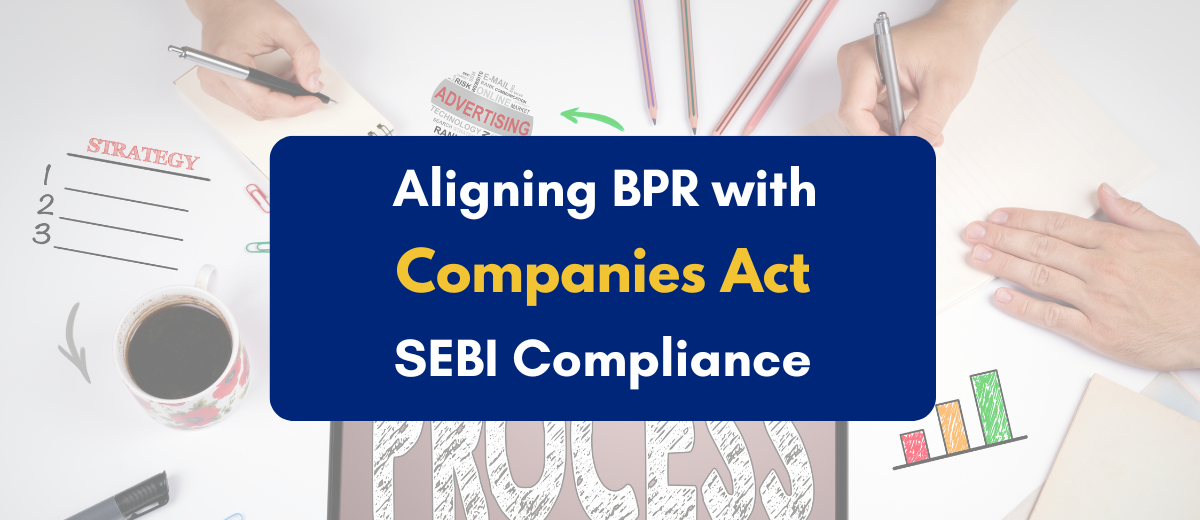Written By – PKC Desk, Edited By – Pranaveeka, Reviewed By – Balaji Prasath
BPR is widely regarded as a strategic approach to streamline operations, cut expenses, and enhance the customer experience. In India’s increasingly regulated business environment, BPR initiatives cannot be pursued in isolation.
It must comply with key statutory and regulatory frameworks like the Companies Act, 2013 and the SEBI (Listing Obligations and Disclosure Requirements) Regulations, 2015. The question isn’t just how can we reengineer processes for performance, but can we do it without risking compliance breaches?
Let’s explore how companies can align BPR initiatives with legal mandates and why failing to do so could backfire.After all, process excellence that leads to non-compliance is not progress, it’s a liability dressed as innovation.
Why BPR Must Be Grounded in Compliance?
BPR involves rethinking and redesigning core business processes. This typically includes redefining roles, eliminating redundant controls, digitizing documentation, and centralizing operations.
While these efforts drive efficiency, they can unintentionally lead to regulatory non-compliance if not handled carefully.
Examples of potential missteps:
- Automating financial reporting without proper oversight could contravene Section 134 and 143 of the Companies Act related to Director’s Report and Auditor responsibilities.
- Delegating material decisions without a clear board-approval framework could breach SEBI’s LODR norms on governance and disclosure.
- Overriding internal audit mechanisms during streamlining may compromise the spirit of Section 138 of the Companies Act which mandates internal audit for prescribed class of companies.
In each of these cases, the cost of “efficiency” can spiral into reputational damage, regulatory sanctions, and even management shakeups.
Need Help Pace Up Your Business, Get in Touch Today!
Understanding the Compliance Landscape
Before initiating any BPR project, companies must map their processes against relevant compliance checkpoints. Here’s a simplified breakdown of key legal provisions that influence process design:
Under the Companies Act, 2013:
- Board Structure and Responsibility (Section 149–172): BPR affecting roles and responsibilities must respect board independence, committee roles, and meeting protocols.
- Internal Controls & Audit (Section 134, 138): Any change in financial reporting or operational control must preserve internal control integrity.
- Related Party Transactions (Section 188): Processes must ensure transparent documentation and approval of related party dealings.
- Record Maintenance (Section 128): Even if processes are digitized or outsourced, books of account must be accessible and auditable in India.
Under SEBI (LODR), 2015:
- Timely Disclosure (Regulation 30): BPR must not hamper the ability to make prompt, material disclosures to stock exchanges.
- Financial Reporting Timelines (Regulation 33): Any redesign of accounting or data consolidation must adhere to quarterly and annual filing deadlines.
- Board and Shareholder Approval Processes (Regulation 17): Governance-centric processes cannot be oversimplified at the cost of regulatory non-compliance.
How BPR Can Be Made Compliance-Ready?
It’s tempting to design BPR with only efficiency metrics in mind. But here’s where you must pause. Below are practical ways to integrate compliance with BPR:
- Compliance-First Mapping
While performing As-Is and To-Be process mapping, tag each activity with applicable compliance references (Companies Act sections, SEBI regulations, etc.). This prevents process gaps that might later cause audit flags or penalties.
- Involve the Compliance Officer from Day One
Don’t loop in the compliance function post-design. Embed them into the core BPR team. Their lens ensures that workflows retain necessary audit trails, reporting hierarchies, and approval matrices.
- Digitization with Retention
BPR often brings digitization. However, be skeptical about cloud-first or outsourced systems if they fail to meet data residency, access, and inspection requirements under Indian laws.
- Risk-Based Governance Integration
Re-engineer processes in a way that naturally embeds controls. For example, if a manual process required dual authorization, its digital counterpart must retain the same rigor via role-based access or system controls.
- Internal Audit as a Gatekeeper
No redesigned process should go live without being vetted by the internal audit team
This guarantees adherence to both operational goals and legal protections.
Case Study: Procurement Process Redesign
Imagine a listed company reengineering its procurement process to enable faster vendor on boarding and automated payments.
What Could Go Wrong?
- If the process lacks check for related party transactions → Violation of Section 188
- If payment cycles shift without disclosing changes to material contracts → SEBI disclosure breach
- If internal audit controls are removed in the name of agility → Non-compliance under Section 138
Efficiency without oversight here could mean regulatory fines, shareholder distrust, and operational chaos.
Advantage of Compliance in BPR
What if compliance wasn’t the cost of doing business but a value differentiator?
Companies that successfully embed legal and regulatory frameworks into their process redesign often experience:
- Smoother Audit: Internal and external auditors spend less time filling in the gaps.
- Higher investor confidence: SEBI-compliant disclosures lead to better investor relations.
- Board alignment: Directors are assured that operations remain within legal boundaries.
- Resilience in scrutiny: Whether under MCA inspection, SEBI queries, or whistle-blower probes, well-designed processes hold up.
If BPR is about future-proofing operations, then alignment with the Companies Act and SEBI regulations is not optional, it’s essential.
Businesses that treat compliance as a strategic enabler, not a bottleneck, are more likely to innovate sustainably and scale confidently.
So the next time you reengineer a process, don’t just ask:
“Is it efficient?”
Ask: “Is it compliant, auditable, and resilient?”
That’s where true transformation begins.
Author Divyadharshini M


 Expert verified
Expert verified 

